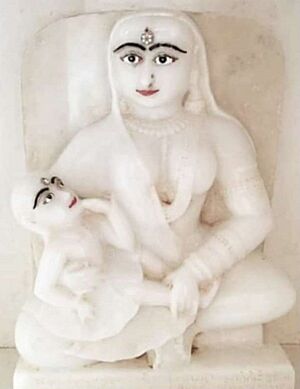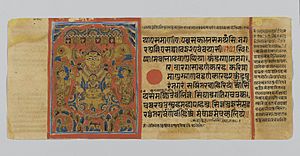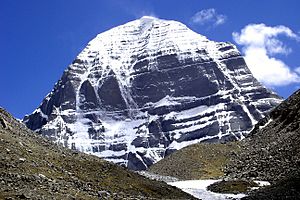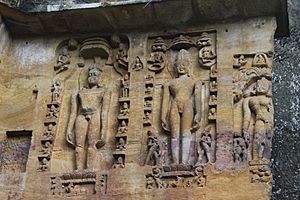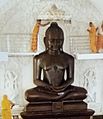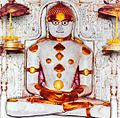Rishabhanatha facts for kids
Quick facts for kids Rishabhanatha |
|
|---|---|
| 1st Jain Tirthankara | |
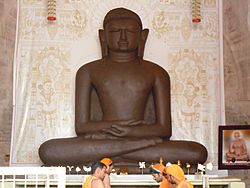
The 15 feet (4.6 m) "Bade Baba" idol of Lord Rishabhanatha at Bade Baba temple, Kundalpur
|
|
| Other names | Adinatha, Aadeshwar, Aadish Jina (first conqueror), Adarsh Purush (first Perfect Man), Ikshvaku |
| Predecessor | Shri Sampratti Bhagwan (last Tirthankar of previous time cycle) |
| Successor | Shri Ajitnath Bhagwan |
| Symbol | Bull |
| Height | 500 bows (1312 ells, 4920 feet) |
| Age | 8.4 million purvas (592.704×1018 years) |
| Tree | Banyan |
| Color | Golden |
| Personal information | |
| Born | Ayodhya |
| Died | Mount Asthapada |
| Spouse | Sunanda & Sumangala |
| Children | 100 sons including Bharata Chakravartin and Bahubali, and two daughters: Sundari, Brahmi |
| Parents |
|
Rishabhanatha, also known as Adinatha, was the very first Tirthankara (a great spiritual teacher) in Jainism. He is seen as the founder of the Jain faith in our current time cycle. People also call him "ford maker" because his teachings help people cross the "sea of rebirths and deaths" (called samsara).
Jains believe Rishabhanatha lived millions of years ago. He was the spiritual leader who came after Sampratti Bhagwan, the last Tirthankara of the previous time cycle. His name, Adinatha, means "First Lord." He is one of the five Tirthankaras most worshipped by Jains, along with Mahavira, Parshvanatha, Neminath, and Shantinath.
Stories say he was born in Ayodhya, a city in northern India. His parents were King Nabhi and Queen Marudevi. He had two wives, Sunanda and Sumangala, and many children. One day, he saw a dancer named Nilanjana suddenly die. This made him realize that everything in the world changes and doesn't last forever. This feeling made him want to give up his royal life and become a monk.
After becoming a monk, Rishabhanatha traveled for a whole year without eating. The day he finally received food is celebrated by Jains as Akshaya Tritiya. He achieved Moksha (freedom from rebirth) on Mount Asthapada. The book Adi Purana tells the story of his life and teachings. Large statues of him can be found in places like Statue of Ahimsa and Bawangaja. His symbol is the bull.
Contents
Life of Rishabhanatha
Rishabhanatha is known by many names like Adinatha and Yugadeva. The Ādi purāṇa is a main Jain text that tells the story of his life. In Jain tradition, a Tirthankara's life has five special events called pancha kalyanaka. These are:
- Garbha: When the mother becomes pregnant.
- Janma: The birth.
- Tapa: The time of penance (strict self-discipline).
- Keivalyagyana: When they gain all knowledge (omniscience).
- Moksha: When they achieve liberation.
Jain beliefs state that the universe has no beginning or end. Time moves in cycles, with 24 Tirthankaras appearing in each half-cycle. Rishabhanatha is the first Tirthankara of our current time cycle. Jain texts say he lived millions of years ago. While some scholars see the first 22 Tirthankaras as mythical, Jains believe they were real figures.
His Birth Story
Rishabhanatha was born to King Nabhi and Queen Marudevi in Ayodhya. This city is holy for Jains because of his birth, just as it is for Hindus because of Rama's birth. In Jain tradition, a Tirthankara's mother has 14 special dreams before their birth. Marudevi is believed to have had these dreams, which showed that her son would be a great spiritual leader.
Family and Teachings
Rishabhanatha had two wives, Sunanda and Sumangala. Sumangala was the mother of 99 sons, including Bharata, and one daughter, Brahmi. Sunanda was the mother of Bahubali and Sundari. Jain texts say Rishabhanatha taught his daughters important skills. He taught Brahmi the Brahmi script (a writing system) and Sundari the science of numbers. His oldest son, Bharata, became a king and ruled ancient India from Ayodhya.
Starting New Ways of Life
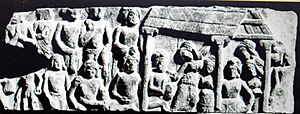
Rishabhanatha was born in a time called bhoga-bhumi, where people lived happily without working. They got everything they needed from magical trees called kalpavrikshas. But as time passed, these trees became less helpful. So, people asked the king for help.
Rishabhanatha then taught them six main ways to live and work:
- Asi: Swordsmanship for protection.
- Masi: Writing skills.
- Krishi: Agriculture (farming).
- Vidya: Knowledge.
- Vanijya: Trade and business.
- Shilp: Crafts.
He is seen as the one who started karma-bhumi (the age of action), where people work to support themselves. He also taught people how to use fire, cook, and many other skills. In total, he taught 72 sciences to men and 64 to women. He also set an example for marriage. Because of this, Rishabhanatha is not just a spiritual teacher but also a hero who brought knowledge and culture to humanity.
He was the first king to set up a capital city, Vinitanagara (Ayodhya). He also created the first laws for how a king should rule. He started a system of three groups of people based on their jobs:
- Kshatriyas: Warriors.
- Vaishyas: Merchants.
- Shudras: Manual workers.
His son, Bharata, later added a fourth group, the Brahmins.
Becoming a Monk
Jain stories tell of a dance performance in Rishabhanatha's palace. During the dance, one of the dancers, Nilanjana, suddenly died. This event made Rishabhanatha deeply realize that life is temporary. This feeling led him to decide to give up his kingdom, family, and all his wealth.
He then divided his kingdom among his 100 sons. Bharata received Ayodhya, and Bahubali received Podanapur. Rishabhanatha became a monk in the Siddharta-garden, outside Ayodhya, under an Ashoka tree.
Akshaya Tritiya Celebration
Jains believe that when Rishabhanatha became the first monk, people didn't know how to offer food to a monk. After fasting for 13 months, his great-grandson, Shreyansa, a king from Gajapura (now Hastinapur), offered him sugarcane juice. This broke his long fast. Jains celebrate this event every year as Akshaya tritiya on the third day of the bright half of the month of Vaishaka (usually in April). It marks the beginning of the tradition of offering food to monks.
Gaining All Knowledge
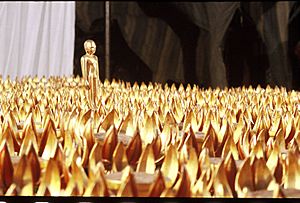
Rishabhanatha spent a thousand years practicing very strict self-control. Then, he achieved kevala jnana (all-knowing wisdom) under a banyan tree. After this, heavenly beings are said to have created special preaching halls called samavasaranas for him. There, he taught the five main vows for monks and 12 smaller vows for regular people. He also set up the sangha (the four-part religious community) which included male monks, female monks, and male and female followers.
Achieving Liberation
Rishabhanatha traveled widely, teaching the principles of Jainism. At the end of his life, he achieved Nirvana or moksha. This means his soul became free from the endless cycle of rebirths and reached a state of eternal peace. Jains believe this happened on Ashtapada (also known as Mount Kailash). Stories say that heavenly gods came to cremate his body with special offerings.
In Literature
The Ādi purāṇa, a Sanskrit poem from the 9th century, tells the story of Rishabhanatha's life and his two sons. His life is also described in other important Jain texts like Mahapurana and Kalpa Sutra. The Bhaktamara Stotra is a famous prayer that mentions Rishabhanatha.
Rishabhanatha is also mentioned in some Hindu texts, like the Rigveda and Bhagavata Purana. In later Hindu texts, he is sometimes described as an avatar (a form) of Vishnu. He is also mentioned in Buddhist texts, which speak of several Tirthankaras.
Iconography
Rishabhanatha is usually shown in a lotus position or a standing meditation pose called kayotsarga. You can recognize him by his long hair that falls on his shoulders and a bull symbol carved below his feet. Paintings often show important moments from his life, like his marriage or when Indra performs a special ceremony called abhisheka. He is sometimes shown teaching people skills like pottery or weaving. His mother Marudevi's visit is also a common scene in paintings. He is linked with his Bull emblem, the Nyagrodha tree, Gomukha (a bull-faced spirit), and Chakreshvari (a goddess).
The Statue of Ahimsa is a huge statue of Rishabhanatha, carved from a single rock. It is 108 feet (33 m) tall (or 121 feet (37 m) with its base) and is considered the world's tallest Jain idol. It is located near Mangi-Tungi hills in Maharashtra, India.
In Madhya Pradesh, there is Bawangaja hill, which has a large Rishabhanatha statue carved from volcanic rock. The 58.4 feet (17.8 m) Rishabhanatha Statue at Gopachal Hill in Gwalior Fort is another important site. Thousands of Jain idols were carved there between 1398 A.D. and 1536 A.D.
-
Idol of Lord Rishabhdeva at Palitana Tirth, Gujarat
Temples
Rishabhanatha is one of the five most worshipped Tirthankaras. Many Jain temples across India are dedicated to him and are important pilgrimage sites. Mount Shatrunjaya in Gujarat is a holy place where 23 of the 24 Tirthankaras are believed to have preached. Many monks are said to have found liberation there. A large temple in this complex is dedicated to Rishabhanatha. The main statue there is called Adinatha or Dada (grandfather).
Some important Rishabhanatha temple complexes include Palitana temples, Dilwara Temples, Kulpakji, Kundalpur, Paporaji, Soniji Ki Nasiyan, Rishabhdeo, Sanghiji, Hanumantal Bada Jain Mandir, Trilok Teerth Dham, Pavagadh and Sarvodaya Jain temple.
-
Ranakpur Jain temple, Ranakpur, Rajasthan
-
Adinatha temple, Khajuraho, a UNESCO World Heritage Site
See also
 In Spanish: Rishabha (tirthankara jaina) para niños
In Spanish: Rishabha (tirthankara jaina) para niños


